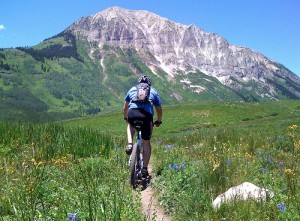
A mountain biker rides near Crested Butte, Colo. When the 1964 Wilderness Act set aside lands “where the earth and its community of life are untrammeled by man,” mountain bikes didn’t exist and bicycle riding in the forest was a rarity. Photo by Flickr user Trailsource.com.
Mountain bikers are barred from wilderness areas. But some cyclists are arguing for a Wilderness B designation: wilderness with bikes. Not all wilderness advocates are sold on the idea, though.
Hikers and mountain bikers may have a lot of things in common, but wilderness isn’t one of them. Where the wilderness boundary starts, mountain bikes have to stop, creating a rift between sometimes-allies as environmentalists seek new wilderness areas at the expense of beloved mountain bike trails.
But some mountain bikers are rallying around a new idea they call “Wilderness B,” or wilderness with bikes. They’re pressing for a new type of wilderness designation that would allow bikes to roll through protected landscapes alongside hikers and horses.
On an otherwise anonymous Facebook page that chronicles conflicts between mountain bikers and wilderness advocates, they argue bikes have less impact on the land than hikers, and they urge supporters to press elected officials to create “a sister designation” to wilderness, one with all of wilderness protections, and with bikes.
“Mountain bikers are staunch preservationists and to date the Wilderness lobby has self-servingly lobbied against the inclusion of bicycles,” the Facebook site says.
“Wilderness B is really targeted at how can we create new forms of land protection,” said Mark Eller, spokesman for the Boulder, Colo.-based International Mountain Biking Association, which generally supports the idea of Wilderness B but says it isn’t behind the movement.
IMBA often supports wilderness plans gerrymandered to carve out areas for mountain bikers. “Those are all good,” Eller said. “They’re better than nothing. But what we’d really like to see is the same kind of gold standard of land protection as wilderness that would allow bicycles.”
But many wilderness advocates say wilderness areas aren’t the place for bikes.
“One of the big values of wilderness is to slow down. To be quiet. To be amidst nature on its own terms,” said Suzanne Jones, Denver regional director of The Wilderness Society, which rejects bikes in the wilderness.
When the 1964 Wilderness Act set aside lands “where the earth and its community of life are untrammeled by man,” mountain bikes didn’t exist and bicycle riding in the forest was a rarity. The act bars “mechanical transport” in wilderness areas, but exactly what that means is at the center of the debate.
IMBA insists that bikes were never intended to be barred from wilderness, and that a 1966 regulation allowing for any human-powered transport specifically allowed them. In 1977, bicycles and hangliders were specifically forbidden, though, and in 1984, a new set of regulations cut out various wheeled transportation, from bikes to baby strollers.
“Nobody denies that a bicycle is a mechanical device. The question is what kinds of mechanical devices Congress wanted to allow,” said Ted Stroll, a San Jose, Calif., mountain biker and lawyer who has advocated for including bikes in wilderness in publications from the New York Times to the Penn State Law Review.
If land managers wanted to exclude all mechanical devices, Stroll said, they’d have to exclude shock-absorbing hiking poles, high-tech ski bindings and fishing rods.
Wilderness advocates say Congress knew what it was doing when it banned not just motorized but mechanized transport.
“It’s important that there are places that are still big, where the peace of nature is what prevails, the forces of nature shall hold forth,” Jones said. “What is a three-day (backpacking trip) could be somebody’s afternoon workout on a mountain bike.”
Wilderness B advocates seek to sidestep the arguments over allowing bikes in wilderness by creating a new designation. Many wilderness advocates, though, believe that rather than strengthening ordinary land protections, Wilderness B would dilute wilderness-worthy landscapes.
“I think it’s unfortunate for mountain bikers to decide they want to take away from wilderness protection rather than enlarge landscape protection more broadly,” Jones said. “I mountain bike. I drive a car. I support wilderness. Those are not incompatible at all. There’s a place for everything. I believe wilderness should be wilderness.”
The issue has come to a head on the White River National Forest in western Colorado, where the group Wilderness Workshop is proposing 340,000 acres for Hidden Gems wilderness protection. IMBA has endorsed a portion of that plan, which would protect 88,710 new acres of wilderness in Eagle and Summit counties and create special management areas on 80,000 acres, where mountain biking would be allowed.
Elsewhere on the forest, though, mountain bikers have balked at new wilderness.
“The mountain biking community is not homogenous,” said Wilderness Workshop Executive Director Sloan Shoemaker. “There are extremes on both ends of that community. The one extreme believes all wilderness should be eliminated and mountain bikers should be able to go where they want.”
Mountain bikes may have a light footprint when it comes to trail impacts, Shoemaker said, but they can take a toll on wildlife.
“It’s the ability for a mountain biker, a strong mountain biker on today’s machines, to cover 60 miles in a day,” he said. “That shrinks those last wild places pretty small and spreads the reach and impact and disturbance pretty broadly across the landscape.”
Shoemaker said he could support something like a Wilderness B, a wilderness for bikes, as long as it adds to land protections rather than takes them away.
“I think there’s merit to this notion,” he said, “but our community doesn’t embrace it as a substitute. We embrace it as an addition to wilderness quality lands.”


